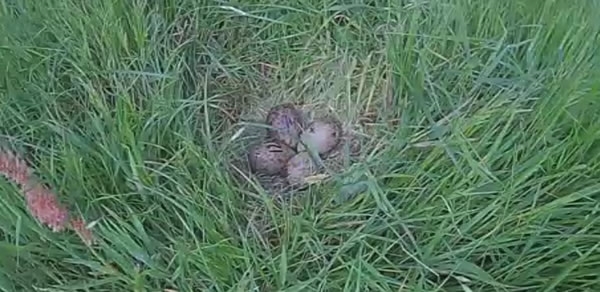By Amanda Perkins, Curlew Country Project Manager
Over the weekend the first chicks arrived from nests being protected as part of the Curlew Country project. They did not hatch in the wild, but from our incubators which this year are full of curlew eggs taken from as many first nest attempts as possible. If a curlew fails to nest at egg stage it may go on to try again and lay a second clutch of eggs, but not always.
 Image taken from Curlew Cam
Image taken from Curlew Cam
During the first two years of the project, from over 30 nests monitored with cameras and data loggers, no chicks survived to hatch. Most were predated at egg stage by foxes which were responsible for over 50% of predation events and badgers were the next highest cause of failure at under 25%.
Curlew Country is focussed on lowland curlew recovery and acts quickly to try and do all it can to win the race against time to save these iconic birds. After the first two dismal years of monitoring the failure of the local but nationally significant hotspot of breeding curlews, last year it took positive action to take steps to help reverse the decline.
Protective electric fences were used around curlew nests – first on mainland UK and trial areas of predator control were introduced (it is expensive to fund predation control and many funders will not pay for this although we are fortunate to have good volunteers helping us in some areas). It also applied for a licence to ‘headstart’ another first in the UK, although it has been successfully trialled in Europe.
What is 'headstarting'?
‘Headstarting is the process of removing eggs and incubating them and may result in the rearing of chicks. The intention of the project this year was to take the first clutch of eggs laid by the curlew pairs and incubate them. Some curlew will have a second attempt at breeding, although the numbers vary from year to year depending on a number of factors.
The plan was to return the incubated eggs to the birds once they had laid their second clutch, taking those eggs to incubate them and rear them as chicks. However, each season is different and nature defies plans regularly. The beast from the east and other late cold weather delayed nesting and caused difficulties for our farming partners. This in turn meant that they were out late rolling, harrowing and fertilising fields that we had not had the opportunity to find nests in.
We were however delighted to be able to find a good number of nests quickly in a shorter space of time than usual. The grass had not grown enough to hide the birds from us completely and the farmers and volunteer helpers were all better informed and trained in what to look for. The whole team was finding nests. Last year our nest finding was all but over in May even with second clutches. This year many birds do not seem inclined to try again and those that do are well hidden in luxuriant grass growth which is the product of glorious May sunshine after much rain.
Birds that had feasted in the wet earlier weather have been struggling to probe their long bills into the hard ground following the dry weather and we are wondering how many will try to nest again, we are not seeing much activity yet. The Curlew Cam birds alarmed us and viewers one night with a long absence from the nest. We do not know what caused the bird to leave the nest, but the unusually long absence of the pair may suggest that they were taking the time to forage to make up for loss of feeding opportunities following the lack of rain.
We were keen to release at least some chicks back into the natural environment. We have three nests with birds sitting so that we can do this. Curlew Cam is one of them. The birds are sitting on infertile duck eggs donated by one of our volunteer nest finders. They have been painted to look more similar to curlew eggs and are not dissimilar in size although they are a little less shapely. Clutches of ‘pipping’ eggs – eggs in the early stages of hatching were to be returned to the nest as appropriate.
The nests have fences around them. We cannot put a fence up until the female has laid a full clutch of eggs as the birds are very sensitive to disturbance and may abandon the nest. Several nests that we had hoped to fence and leave sitting on duck eggs until ‘pipping’ curlew eggs were swapped with them, were predated before we could achieve this. The loss of these nests is a reminder that headstarting with all its risks, cannot have a lesser chance than leaving the birds to fend for themselves naturally.
Please support the vital Curlew Country project
Curlew Country carries out pioneering work to save lowland curlew. It needs funding to continue its vital work. Please help to save curlew.